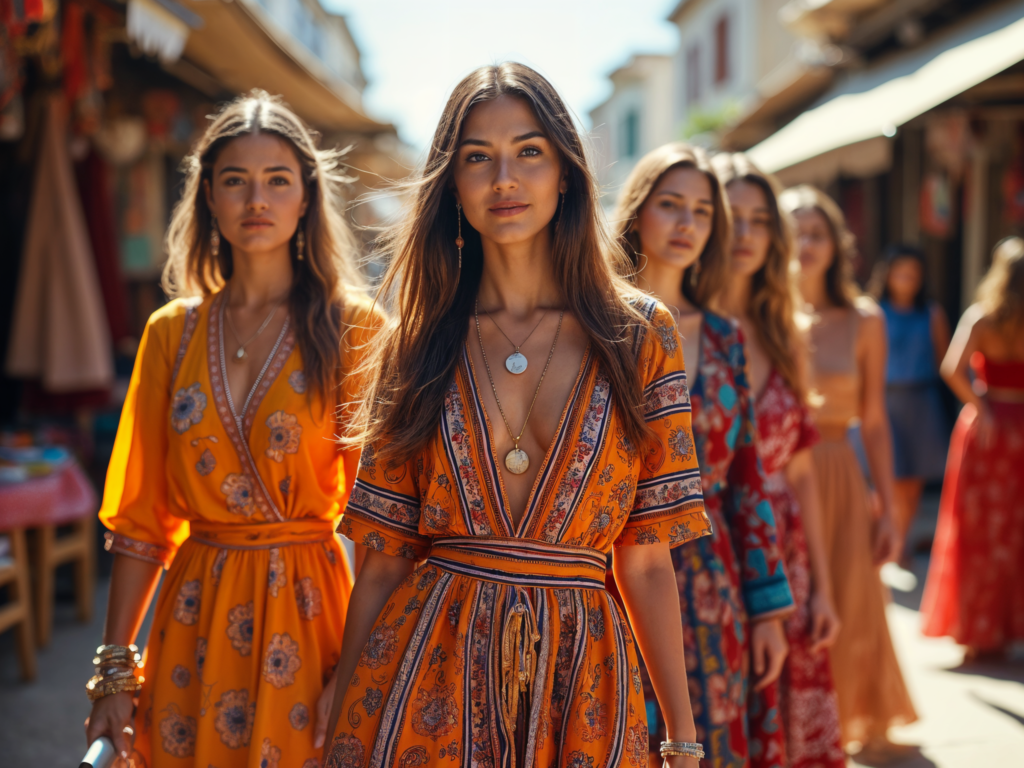
Introduction to Ethnic Wear Trends
Ethnic wear has always been a crucial aspect of cultural identity, offering a glimpse into the rich traditions and craftsmanship of various regions. As we step into 2024, the relevance of ethnic wear continues to grow, seamlessly blending traditional aesthetics with contemporary fashion trends. This evolution not only caters to the modern woman’s style preferences but also reflects a deeper appreciation for cultural heritage and craftsmanship.
The fusion of traditional elements with modern designs is more evident than ever. Designers are increasingly experimenting with fabrics, cuts, and patterns that honor authentic ethnic styles while appealing to contemporary tastes. For instance, intricate embroidery and handwoven textiles that were once reserved for festive occasions are being incorporated into everyday wear. This shift signifies a move towards a more versatile approach to ethnic fashion, making it accessible for diverse occasions, from professional settings to casual outings.
Moreover, in 2024, we are witnessing a rise in sustainability within the ethnic wear sphere. More brands are emphasizing eco-friendly practices and responsible sourcing, allowing women to don their ethnic attire with pride. This commitment not only meets the growing demand for sustainable fashion but also showcases the timelessness of traditional craftsmanship that is often aligned with sustainable practices. As a result, ethnic wear not only links the modern woman to her roots but also encourages an eco-conscious lifestyle.
Overall, the ethnic wear trends of 2024 encapsulate a unique blend of tradition and modernity. This adaptation reflects the evolving landscape of fashion wherein cultural appreciation and contemporary innovation coexist. As we delve deeper into the latest styles, patterns, and influences shaping ethnic wear, it becomes clear that this fashion genre will continue to hold significance in the years to come.
Key Trends to Watch in 2024
As we approach 2024, the landscape of ethnic wear for women is set to witness a remarkable evolution that fuses traditional elements with contemporary fashion sensibilities. This year, several notable trends are emerging, reflecting not only aesthetic choices but also broader societal changes and a focus on women’s empowerment.
One of the most prominent trends is the resurgence of natural fabrics, such as cotton, silk, and linen. These materials not only offer comfort but also align with the growing global emphasis on sustainability and eco-friendly practices in fashion. Designers are increasingly opting for organic textiles that are both chic and environmentally conscious, catering to the modern woman’s lifestyle while honoring traditional craftsmanship.
In terms of colors, the palette for 2024 is expected to skew towards vibrant hues and luxurious pastels. Jewel tones, such as emerald green, deep burgundy, and sapphire blue, will dominate the ethnic wear scene, serving to enhance the festive spirit while also reflecting individuality. Additionally, soft pastels like mint green and blush pink will make their mark, bringing a sense of serenity and elegance to traditional attire.
Patterns and styles are likewise evolving, with a shift towards asymmetrical cuts and intricate embroidery that showcase artistic expression. Geometric patterns and floral motifs are making a statement, reflecting cultural heritage while appealing to the tastes of younger women. Layered silhouettes, such as long jackets paired with traditional skirts or pants, will provide versatility and comfort, suitable for various occasions.
Overall, these key trends not only highlight the dynamic nature of ethnic wear but also encapsulate the spirit of empowerment among women. By embracing these styles, women are not only honoring their roots but also expressing their unique identities in a rapidly changing world. The fusion of tradition and modernity in ethnic wear in 2024 is a testament to the evolving role of women in society.
The Rise of Sustainable Fashion in Ethnic Wear
In recent years, the fashion industry has witnessed a significant shift towards sustainability, a trend that has gained remarkable traction within the realm of ethnic wear. This move is largely influenced by a growing awareness around environmental issues, prompting both consumers and designers to prioritize eco-friendly practices. Ethnic wear, traditionally rich in cultural significance, is now being redefined through the lens of sustainable fashion.
One of the pivotal aspects of this transition is the adoption of eco-friendly fabrics. Designers are increasingly turning to organic cotton, natural dyes, and sustainable materials such as hemp and bamboo. These fabrics not only reduce the carbon footprint associated with manufacturing but also resonate with the ethos of ethnic fashion, which often emphasizes connection to nature and traditional craftsmanship. The use of such materials is not limited to high-end designers; many brands now offer accessible lines that make sustainable ethnic wear available to a broader audience.
Furthermore, ethical sourcing has become a cornerstone of contemporary ethnic fashion. The focus is shifting towards transparency in the supply chain, ensuring that artisans and manufacturers are treated fairly and paid adequately. This holds particular significance in the production of ethnic garments, where many pieces are handcrafted by skilled artisans who have been passing down their techniques through generations. By supporting ethical sourcing, consumers contribute to the preservation of traditional art forms while also promoting fair labor practices.
The shift towards handmade garments is also indicative of the rising value placed on uniqueness and quality. In a world dominated by fast fashion, handmade ethnic wear offers an antidote, allowing individuals to express their personal style while supporting sustainable practices. This trend is not only about clothing but also represents a lifestyle choice that values craftsmanship, ethics, and sustainability. As we navigate through 2024, it is clear that the fusion of tradition and modernity in ethnic wear is deeply intertwined with the principles of sustainability, reshaping how consumers engage with fashion.
Fusion Styles: Blending Ethnic and Contemporary Fashion
The evolving landscape of fashion has led to a delightful fusion of ethnic and contemporary styles, especially in women’s wear for 2024. This unique blending of traditional ethnic pieces with modern aesthetics allows women to explore a multitude of options that cater to diverse occasions, from casual outings to formal events. The contemporary interpretations of ethnic wear offer a fresh perspective, ensuring that age-old traditions remain relevant in today’s fashion scene.
One prevailing trend is the incorporation of traditional fabrics, such as silk and cotton, into contemporary silhouettes. For instance, a classic lehenga may be paired with a structured blazer to create a business-friendly yet festive look. This combination not only demonstrates an appreciation for heritage but also boosts versatility, enabling outfits to transition seamlessly from day to night. Such styles exemplify how ethnic garments can serve modern purposes without losing their charm.
Another fascinating approach is the use of statement accessories paired with ethnic attire. Chunky jewelry, designer handbags, and stylish footwear can elevate traditional outfits, giving them a contemporary edge. A saree, complemented by a bold, modern belt or an oversized clutch, illustrates how women are redefining ethnic wear while maintaining its cultural significance. These accessories function as a bridge, creating seamless links between the two distinct fashion realms.
Furthermore, patterns and prints are also evolving, with designers embracing vibrant motifs from traditional textiles while incorporating minimalist designs common in modern fashion. By blending these elements, women are crafting personalized styles that resonate with both cultural heritage and contemporary flair. This captivating evolution in ethnic fashion not only showcases creativity but also emphasizes the importance of comfort and individuality in women’s attire today.
Cultural Significance of Ethnic Wear in Today’s Society
Ethnic wear plays a vital role in maintaining and expressing cultural identity in today’s rapidly globalizing world. Clothing often serves as a canvas for showcasing heritage, embodying community values, and narrating personal stories. In many cultures, wearing traditional attire signifies pride and respect for one’s roots, allowing individuals to honor their ancestors and the traditions that have shaped their lives. The intricate designs, distinctive fabrics, and elaborate embellishments that characterize ethnic wear typically tell stories passed down through generations, making each garment not just an article of clothing but a testament to the heritage it represents.
Moreover, ethnic wear fosters a sense of belonging within communities. It often serves as a collective identity marker, highlighting common values and shared histories among individuals. During festive occasions, cultural gatherings, or ceremonial events, ethnic attire unites people, reinforcing social bonds and local customs. In this context, wearing ethnic clothing transcends personal choice; it becomes a meaningful act of representation and solidarity with one’s culture and community.
However, globalization has brought about significant changes to ethnic wear, influencing how traditional apparel is perceived and worn. While this phenomenon has occasionally resulted in the dilution of cultural practices, it has also led to a dynamic fusion of styles. Contemporary designers are incorporating traditional elements into modern fashion, enabling ethnic wear to evolve while still retaining its cultural essence. This blending of styles signifies an adaptive approach to cultural expression, allowing individuals to navigate their identities in a multicultural world. As a result, ethnic wear remains relevant, showcasing the continual interplay between tradition and modern fashion, and reflecting the diverse tapestry of today’s society.
Influential Designers Shaping Ethnic Fashion
In 2024, the landscape of ethnic wear for women is being significantly influenced by a group of innovative designers who are seamlessly bridging traditional aesthetics with modern fashion sensibilities. These designers are not only revitalizing ethnic garments but are also redefining the narrative surrounding cultural attire. A few prominent names stand out for their unique approaches to ethnic fashion.
One of the most notable figures is Sabyasachi Mukherjee, whose work combines rich heritage with contemporary flair. Sabyasachi’s collections often feature intricate embroideries, luxurious fabrics, and a quintessential color palette that celebrates Indian artistry. His designs allow women to express their cultural identity while simultaneously standing out in today’s fashion-forward environment. Another key influencer in this realm is Anita Dongre, known for her sustainable practices and eco-friendly materials. Dongre’s designs often reflect a deep respect for tradition, integrating handicrafts and artisanal techniques, which helps to connect modern consumers with India’s rich textile history.
In addition to these established designers, a wave of emerging talent is making significant contributions to the ethnic wear scene. Designers like Masaba Gupta, with her vibrant prints and bold color choices, are attracting the attention of younger audiences and redefining modern ethnic wear. Similarly, Rahul Mishra is celebrated for his exquisite craftsmanship and commitment to sustainable fashion, incorporating nature-inspired themes that resonate with environmentally conscious consumers.
This shift towards innovative designs and responsible fashion choices demonstrates a growing recognition of cultural heritage and individual expression. As these influential designers continue to shape ethnic fashion, they pave the way for a dynamic and diverse representation of traditional wear, ensuring that it remains relevant in the age of modernity and global fashion trends.
Celebrity Influence on Ethnic Wear Trends
The realm of ethnic wear has seen a significant transformation in recent years, largely due to the influence of celebrities and social media personalities. Renowned figures in the fashion industry have become trendsetters, guiding the choices of countless admirers as they merge traditional attire with contemporary styles. Celebrities often showcase ethnic wear during events, award ceremonies, or in their public appearances, which considerably enhances the visibility and desirability of specific garments. Their choices frequently spark trends that quickly catch on among the general populace, creating a ripple effect throughout the fashion landscape.
Collaborations between celebrities and designers have also played a pivotal role in elevating certain ethnic styles. These partnerships often result in exclusive collections that blend traditional craftsmanship with innovative designs, appealing not only to the aesthetic preferences of today’s consumers but also to their desire for unique and statement-making pieces. For instance, Bollywood stars collaborating with established fashion houses have introduced modern silhouettes in lehengas, sarees, and anarkalis, making these traditional garments more accessible to a younger audience looking for trendy options that respect cultural roots.
Social media platforms, particularly Instagram and Pinterest, serve as powerful tools for celebrities to showcase ethnic wear collections, significantly impacting the trends observed in contemporary fashion. Influencers and celebrities share styled photos and behind-the-scenes glimpses, allowing their followers to visualize how they can incorporate ethnic wear into their own wardrobes. This digital dialogue creates an immediate and widespread acceptance of styles that previously may not have received due attention. Consequently, the amalgamation of celebrity endorsements and the ever-present nature of social media facilitates an environment in which ethnic wear trends continually evolve and gain popularity, making them central to modern fashion discourse.
Accessorizing Ethnic Wear: The Perfect Touch
Accessorizing plays a pivotal role in enhancing ethnic wear, allowing individuals to express their unique style while staying true to tradition. The right accessories can elevate an outfit from ordinary to extraordinary, adding depth and character to the overall look. When curating accessories for ethnic outfits, one can consider a variety of elements including jewelry, bags, shoes, and headpieces.
Jewelry is perhaps the most vital component of accessorizing ethnic wear. Traditional pieces such as jhumkas, chokers, and intricate bangles can harmoniously complement an ethnic outfit, adding elegance and grace. Contemporary, minimalist jewelry can also be considered for a modern twist, striking a balance between tradition and today’s fashion trends. Additionally, layering different styles can create an appealing look, allowing for personalization and creativity.
Bags also play a significant role in accessorizing. Opting for clutch bags with intricate embroidery or potli bags can enhance the ethnic vibe. Alternatively, trendy crossbody bags or sling bags adorned with ethnic motifs can fuse traditional elements with modern functionality. The choice of footwear should also align with the outfit; traditional juttis or embellished sandals are suitable for formal occasions, while more contemporary styles may be appropriate for casual outings.
Headpieces are another accessory that can significantly transform an ethnic look. Wearing an elegant maang tikka or traditional matha patti can draw attention to the face, adding a regal touch. Furthermore, contemporary hair accessories can provide a fresh angle, allowing for unique interpretations of traditional attire. While accessorizing ethnic wear, it is essential to strike the right balance; the goal is to enhance the outfit without overpowering it. By thoughtfully selecting accessories, one can achieve a harmonious blend of tradition and modernity, reflecting personal style effortlessly.
Where to Shop for the Latest Ethnic Wear
Shopping for ethnic wear has evolved significantly, with a multitude of options available for women seeking to embrace the latest trends. Whether you prefer the convenience of online shopping or the tactile experience of browsing in physical stores, there are numerous places to find exquisite ethnic pieces in 2024.
Online platforms have become popular destinations for ethnic fashion, offering an extensive range of collections curated by renowned and emerging designers alike. E-commerce giants such as Amazon Fashion and Flipkart feature a variety of brands that cater to different fashion sensibilities. Moreover, specialized platforms like Fabindia, Biba, and W for Woman focus exclusively on ethnic wear, providing diverse selections that include both traditional and modern styles. These online stores also frequently update their collections, showcasing the latest trends and seasonal launches, making them a dependable choice for fashion-forward shoppers.
For those who appreciate a more personal shopping experience, visiting physical stores can be rewarding. Department stores, such as Shoppers Stop and Lifestyle, often have dedicated sections for ethnic attire, featuring well-known brands. Additionally, exploring local boutiques and artisanal shops can uncover unique and handcrafted pieces that stand out in the ever-competitive ethnic wear market. Stores like Chumbak and Kraft Naksha curate collections that celebrate traditional textiles and craftsmanship, contributing to a richer shopping experience.
Moreover, keep an eye out for upcoming collections from both mainstream and artisanal brands as many are launching their summer and festive lines throughout the year. These launches can be an excellent opportunity to discover fresh designs that blend tradition with contemporary aesthetics, solidifying their place within modern fashion. Whether online or in-store, the options for sourcing the latest ethnic wear trends are abundant and varied in 2024.


Pingback: Velvet Dresses 2025: Top 5 Glamorous Styles You Need to Try - Azaayah Fashion Blog